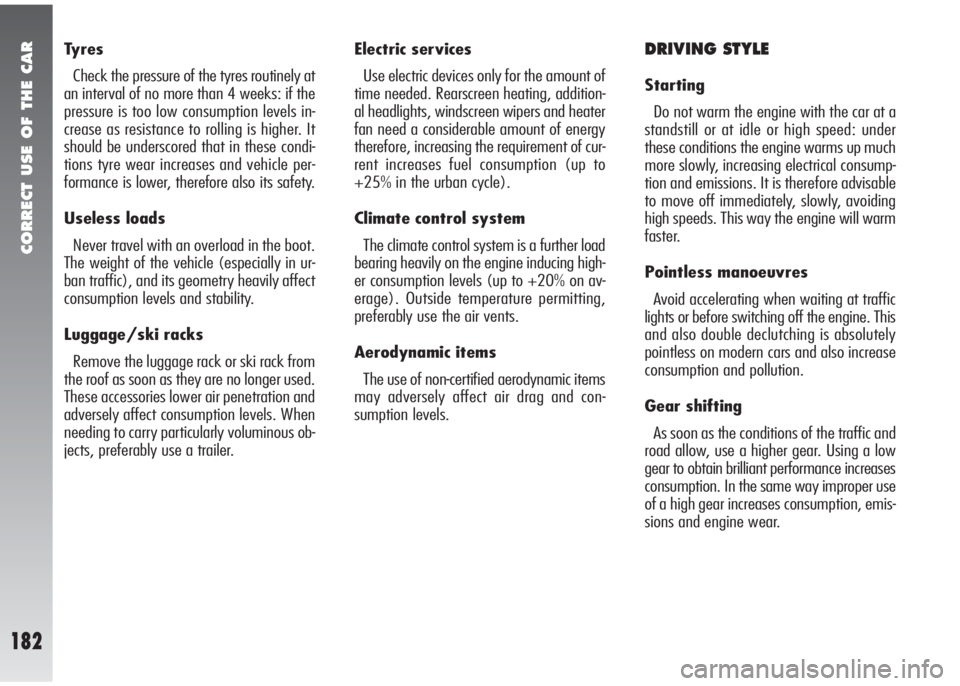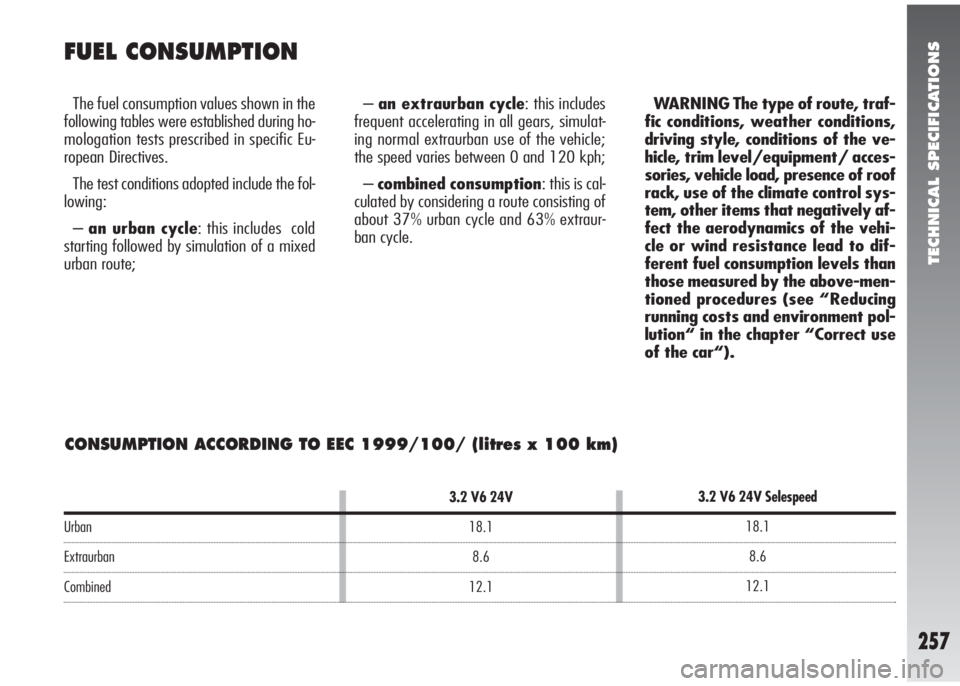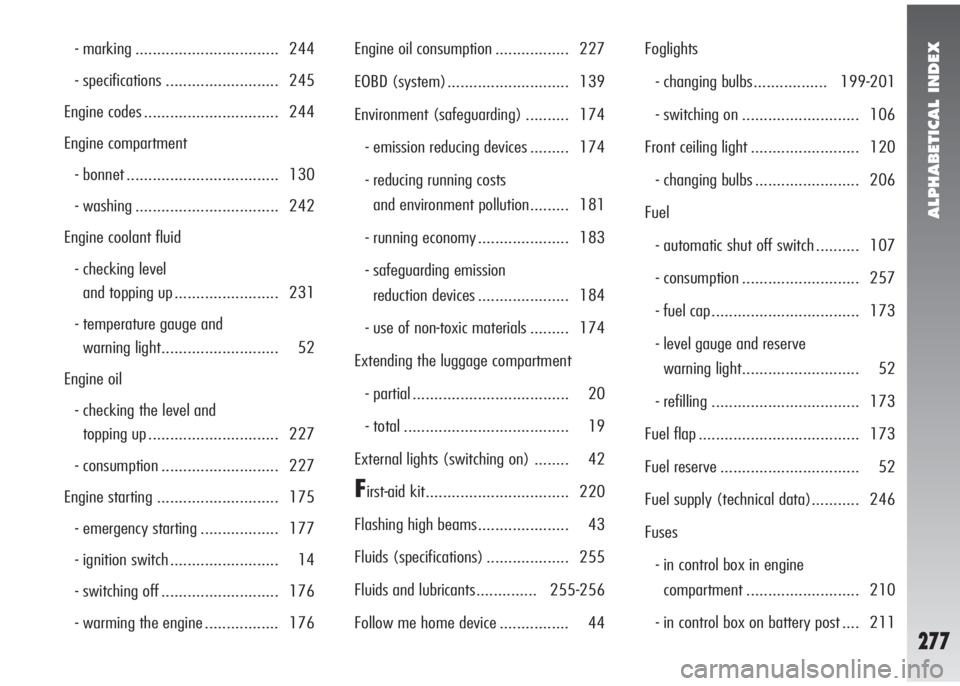fuel consumption Alfa Romeo 147 2007 Owner handbook (in English)
[x] Cancel search | Manufacturer: ALFA ROMEO, Model Year: 2007, Model line: 147, Model: Alfa Romeo 147 2007Pages: 291, PDF Size: 5.52 MB
Page 184 of 291

CORRECT USE OF THE CAR
182
Tyres
Check the pressure of the tyres routinely at
an interval of no more than 4 weeks: if the
pressure is too low consumption levels in-
crease as resistance to rolling is higher. It
should be underscored that in these condi-
tions tyre wear increases and vehicle per-
formance is lower, therefore also its safety.
Useless loads
Never travel with an overload in the boot.
The weight of the vehicle (especially in ur-
ban traffic), and its geometry heavily affect
consumption levels and stability.
Luggage/ski racks
Remove the luggage rack or ski rack from
the roof as soon as they are no longer used.
These accessories lower air penetration and
adversely affect consumption levels. When
needing to carry particularly voluminous ob-
jects, preferably use a trailer.Electric services
Use electric devices only for the amount of
time needed. Rearscreen heating, addition-
al headlights, windscreen wipers and heater
fan need a considerable amount of energy
therefore, increasing the requirement of cur-
rent increases fuel consumption (up to
+25% in the urban cycle).
Climate control system
The climate control system is a further load
bearing heavily on the engine inducing high-
er consumption levels (up to +20% on av-
erage). Outside temperature permitting,
preferably use the air vents.
Aerodynamic items
The use of non-certified aerodynamic items
may adversely affect air drag and con-
sumption levels.DRIVING STYLE
Starting
Do not warm the engine with the car at a
standstill or at idle or high speed: under
these conditions the engine warms up much
more slowly, increasing electrical consump-
tion and emissions. It is therefore advisable
to move off immediately, slowly, avoiding
high speeds. This way the engine will warm
faster.
Pointless manoeuvres
Avoid accelerating when waiting at traffic
lights or before switching off the engine. This
and also double declutching is absolutely
pointless on modern cars and also increase
consumption and pollution.
Gear shifting
As soon as the conditions of the traffic and
road allow, use a higher gear. Using a low
gear to obtain brilliant performance increases
consumption. In the same way improper use
of a high gear increases consumption, emis-
sions and engine wear.
Page 185 of 291

CORRECT USE OF THE CAR
183
Top speed
Fuel consumption considerably increases
with speed: it is helpful to note that passing
from 90 to 120 km/h consumption in-
creases by about +30%. Also maintain an
even as possible speed, avoiding superflu-
ous braking and accelerating again, which
cost in terms of both fuel and emissions. It
is therefore advisable to adopt a “smooth”
driving style trying to anticipate manoeuvres
to avoid imminent hazards and respect safe-
ty distances to avoid sudden slowing.
Acceleration
Accelerating heavily taking the engine to
a high speed, has a considerably adverse ef-
fect on consumption and emission levels;
it is wise to accelerate gradually and not ex-
ceed the maximum torque.CONDITIONS OF USE
Cold starting
Short journeys and frequent cold starts do
not allow the engine to reach optimum op-
erating temperature. This results in a sig-
nificant increase in consumption levels (from
+15 to +30% on the urban cycle) and emis-
sion of harmful substances.
Traffic situations and
road conditions
Rather high consumption levels are tied to
situations with heavy traffic, for example
in queues with frequent use of the lower
gears or in cities with many traffic lights.
Also winding mountain roads and rough
road surfaces adversely affect consumption.
Stopping in the traffic
During prolonged stops (e.g. level cross-
ings) it is advisable to switch the engine off.
ECONOMY AND
ENVIRONMENT
FRIENDLY DRIVING
Environment protection is one of the prin-
ciples that guided the development of your
Alfa 147 GTA.
It is not merely by chance that its antipol-
lution devices obtain results far beyond those
specified by current regulations.
However, the environment still needs the
utmost care from all of us.
By following a few simple rules it is pos-
sible to avoid damage to the environment
and very often at the same time to limit fu-
el consumption. On this subject we are giv-
ing some helpful suggestions to be added
to those marked with the
#in various points
of this booklet.
Kindly read them all carefully.
Page 259 of 291

TECHNICAL SPECIFICATIONS
257
Urban
Extraurban
Combined
3.2 V6 24V
18.1
8.6
12.1
CONSUMPTION ACCORDING TO EEC 1999/100/ (litres x 100 km)
FUEL CONSUMPTION
The fuel consumption values shown in the
following tables were established during ho-
mologation tests prescribed in specific Eu-
ropean Directives.
The test conditions adopted include the fol-
lowing:
–an urban cycle: this includes cold
starting followed by simulation of a mixed
urban route;–an extraurban cycle: this includes
frequent accelerating in all gears, simulat-
ing normal extraurban use of the vehicle;
the speed varies between 0 and 120 kph;
–combined consumption: this is cal-
culated by considering a route consisting of
about 37% urban cycle and 63% extraur-
ban cycle.WARNING The type of route, traf-
fic conditions, weather conditions,
driving style, conditions of the ve-
hicle, trim level/equipment/ acces-
sories, vehicle load, presence of roof
rack, use of the climate control sys-
tem, other items that negatively af-
fect the aerodynamics of the vehi-
cle or wind resistance lead to dif-
ferent fuel consumption levels than
those measured by the above-men-
tioned procedures (see “Reducing
running costs and environment pol-
lution“ in the chapter “Correct use
of the car“).
3.2 V6 24V Selespeed
18.1
8.6
12.1
Page 279 of 291

ALPHABETICAL INDEX
277
- marking ................................. 244
- specifications .......................... 245
Engine codes ............................... 244
Engine compartment
- bonnet ................................... 130
- washing ................................. 242
Engine coolant fluid
- checking level
and topping up ........................ 231
- temperature gauge and
warning light........................... 52
Engine oil
- checking the level and
topping up .............................. 227
- consumption ........................... 227
Engine starting ............................ 175
- emergency starting .................. 177
- ignition switch ......................... 14
- switching off ........................... 176
- warming the engine ................. 176Engine oil consumption ................. 227
EOBD (system)............................ 139
Environment (safeguarding) .......... 174
- emission reducing devices ......... 174
- reducing running costs
and environment pollution......... 181
- running economy ..................... 183
- safeguarding emission
reduction devices ..................... 184
- use of non-toxic materials ......... 174
Extending the luggage compartment
- partial .................................... 20
- total ...................................... 19
External lights (switching on) ........ 42
First-aid kit................................. 220
Flashing high beams..................... 43
Fluids (specifications) ................... 255
Fluids and lubricants.............. 255-256
Follow me home device ................ 44Foglights
- changing bulbs................. 199-201
- switching on ........................... 106
Front ceiling light ......................... 120
- changing bulbs ........................ 206
Fuel
- automatic shut off switch .......... 107
- consumption ........................... 257
- fuel cap.................................. 173
- level gauge and reserve
warning light........................... 52
- refilling .................................. 173
Fuel flap ..................................... 173
Fuel reserve ................................ 52
Fuel supply (technical data)........... 246
Fuses
- in control box in engine
compartment .......................... 210
- in control box on battery post .... 211